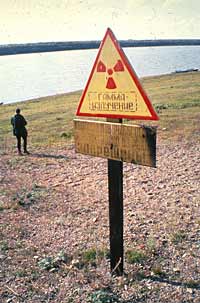
From Ukraine peace plans to Kazakh uranium—all that and more in our new nuclear digest
Our November Nuclear Digest by Bellona’s Environmental Transparency Center is out now. Here’s a quick taste of just three nuclear issues arising in U...
News

Publish date: November 16, 2000
Written by: Vladislav Nikifоrov
News
The report by the U.S. and Russian scientists from organisation Siberian Scientists for Global Responsibility and the US watchdog, the Government Accountability Project, charged that the degree of radioactive contamination measured in the Tom and the Romashka rivers is the highest in the world, Guardian reported. The source of the contamination the Siberian Chemical Combine said the discharge was within norms and accidentally admitted that plutonium has been released into the rivers as well.
The representatives from these organisations said they found caesium and strontium-90 vastly exceeding safety levels in the rivers. But according to professor Panchenko, the more alarming fact is the presence of high levels of phosphorus-32, which decays within a couple of weeks, meaning that the discharge was of very recent origin. Norm Buske, one of the American researchers, an oceanographer and physicist, said fish purchased in a Tomsk market had radiation levels 20 times higher than normal.
The combine dismisses charges
Talking to Russian news agency Interfax, Nikolai Melnik, deputy head of the city administration for security, civil defence and emergency situations in Seversk, has dismissed as absolutely absurd reports about high radiation levels in the area near the chemical combine. If the radioactive levels really exceeded the natural background 30-folds, everything in the area “would simply die out,” he added. Chairman of the regional environmental committee told Interfax that there has been no direct dumping of radioactive waste into the rivers and all liquid radioactive wastes are pumped into underground tunnels. The Russian Nuclear Ministry also claims that the Siberian Chemical Combine is operating in its usual manner and the environmental situation in the area is normal.
and admits plutonium discharge
The representatives of the Siberian Chemical Complex stated, that the water from the plant contains only three radionuclides: natrium-24, phosphorus-32, neptunium- 239, and their concentration in the point of discharge into the river does not exceed the permitted limits for drinking water.
It was also mentioned that such negative information about the plant is plotted by foreign commercial competitors. The combine officials would not specify which competitors they had in mind.
But the most alarming fact in the statement is about neptunium-239, which lives only 2.35 days and after decay transfers into plutonium-239 with life-time of 24,119 years, meaning that plutonium has been accumulating in the river sediments all the decades the combine has been in operation.
Siberian Chemical Combine
The Siberian Chemical Combine site was the next nuclear materials production reactor and reprocessing site to be built in the former Soviet Union after the Mayak reprocessing plant. The site construction began in 1948 at a location 25km north-northwest of the city of Tomsk (about 500,000 population) on the Tom River. Tomsk city limits are now 10km to 12km from the main production facility of Siberian Chemical Combine in Seversk (Tomsk-7), the city located next to the Combine. The worlds largest discharges of radioactive wastes to the environment have occurred here the combination of underground injections and discharges to surface waters.
The two remaining plutonium-producing reactors in operation provide 350 MW of electricity and 600 Gcal/hr of heat. This meets the needs for the combine, the associated city of Seversk, and 40% of Tomsk. In consent with intergovernmental agreement between Russian and the United States, these two reactors were to be converted by 2000 thus halting the production of plutonium. But the deadline was overridden and the project has entered a no-go stage.
Other major facilities are the uranium-enrichment plant (closed in 1990), the conversion plant, the chemical and metallurgical plant, and the fissile material storage.
The direct releases to the Tom river from the discharges of reactor cooling water, and possibly from migration from reservoirs and natural ponds lead to the higher levels of radioactivity in the Kara Sea in Arctic. The releases from the deep-well injection much likely have an impact on the local environment and human health, which is getting especially actual after the Combines statement about neptunium-239 discharge.

Our November Nuclear Digest by Bellona’s Environmental Transparency Center is out now. Here’s a quick taste of just three nuclear issues arising in U...

For three years now, Bellona has continued its work in exile from Vilnius, sustaining and expanding its analysis despite war, repression, and the collapse of international cooperation with Russia in the environmental and nuclear fields

The Board of the Bellona Foundation has appointed former Minister of Climate and the Environment Sveinung Rotevatn as Managing Director of Bellona No...

Økokrim, Norway’s authority for investigating and prosecuting economic and environmental crime, has imposed a record fine on Equinor following a comp...